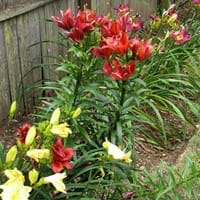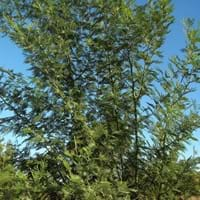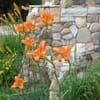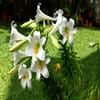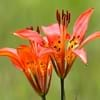Life Span
Perennial
Perennial
Type
Bulb or Corm or Tuber
Tree
Origin
Hybrid origin, North America, Europe, Africa, Asia
Southern Africa, South Africa
Types
White lily, orange lily, Lily of the valley
Acacia aulacocarpa, Papuan wattle, Red wattle
Number of Varieties
Not Available
Habitat
Not Available
Valley, wooded grassland
USDA Hardiness Zone
2-8
9-12
Sunset Zone
21,22
H1, H2, 12, 13, 17, 18, 19, 20, 21, 22, 23, 24
Habit
Upright/Erect
Arching/Fountain-shaped
Flower Color
White, Yellow, Red, Green, Purple, Gold, Pink, Rose, Peach, Burgundy, Bronze
Light Yellow, Lemon yellow
Flower Color Modifier
Bicolor
Bicolor
Fruit Color
Yellow green, Sandy Brown
Tan, Chocolate
Leaf Color in Spring
Green, Dark Green
Green, Gray Green
Leaf Color in Summer
Light Green
Green, Gray Green
Leaf Color in Fall
Several shades of Green
Green, Gray Green
Leaf Color in Winter
Light Green
Green, Gray Green
Leaf Shape
Long Linear
Pinnate
Plant Season
Spring, Summer, Fall
Spring, Summer
Sunlight
Full Sun, Partial Sun, Partial shade
Full Sun
Type of Soil
Clay, Loam, Sand
Loam, Sand
The pH of Soil
Acidic, Neutral, Alkaline
Acidic, Neutral, Alkaline
Soil Drainage
Well drained
Well drained
Bloom Time
Not Available
Spring, Late Spring, Early Summer, Summer
Tolerances
Drought
Drought
Where to Plant?
Container, Ground, Pot
Ground
How to Plant?
Seedlings
Budding, Grafting, Seedlings, Stem Cutting
Plant Maintenance
Medium
Medium
Watering Requirements
Do Not over Water
Keep the ground moist but not water-logged, Keep the Soil well drained, Needs 2-3 times watering per week, Water Deeply
In Summer
Lots of watering
Lots of watering
In Spring
Moderate
Moderate
In Winter
Average Water
Average Water
Soil pH
Acidic, Neutral, Alkaline
Acidic, Neutral, Alkaline
Soil Type
Clay, Loam, Sand
Loam, Sand
Soil Drainage Capacity
Well drained
Well drained
Sun Exposure
Full Sun, Partial Sun, Partial shade
Full Sun
Pruning
Prune in early spring, Prune in fall, Remove dead or diseased plant parts
Remove branches, Remove damaged leaves, Remove dead branches, Remove dead leaves, Remove dead or diseased plant parts
Fertilizers
All-Purpose Liquid Fertilizer, Fertilize only when soil is poor
Apply N-P-K
Pests and Diseases
Lily Beetle
Red blotch
Plant Tolerance
Drought
Drought
Flower Petal Number
Single
Single
Foliage Texture
Not Available
Fine
Foliage Sheen
Not Available
Matte
Attracts
Not Available
Butterflies
Allergy
Not Available
Pollen
Aesthetic Uses
Beautification, Showy Purposes
Showy Purposes
Beauty Benefits
Making cosmetics
Good for skin and hair
Edible Uses
Yes
Insignificant
Environmental Uses
Not Available
Air purification, Nesting sites for birds, Shadow Tree, Wildlife, Windbreak
Medicinal Uses
Burns, Diuretic, Heart problems
Abdominal Disease, Anthelmintic, Back pain, Chest pain, Colic, Cough, Diarrhea, Digestive disorders, Dysentry, Emetic, Febrifuge, Liver problems, Sore Eyes, Stomachic, Tonic, tonic in pregnancy, Tooth ache, Treat Parasitic Intestinal Worms, Treating fever, tuberculosis, Upset stomach, Wounds
Part of Plant Used
Whole plant
Bark, Seeds, Stem, Tree trunks
Other Uses
Cosmetics, Oil is used for aromatherapy, Used As Food, Used as Ornamental plant, Used for its medicinal properties
Gum, Used as fuel, Wood is used for making furniture
Used As Indoor Plant
Yes
No
Used As Outdoor Plant
Yes
Yes
Garden Design
Alpine, Container, Cutflower, Feature Plant, Mixed Border, Wildflower
Feature Plant, Shade Trees
Botanical Name
LILIUM
PELTOPHORUM africanum
Common Name
Lily
Black Wattle, Weeping Wattle
In Hindi
लिली
Black Wattle Tree
In German
Lilie
Schwarz Akazie Baum
In French
Lis
Noir Arbre Wattle
In Spanish
Lirio
Negro del árbol del zarzo
In Greek
Κρίνος
Μαύρο Wattle Δέντρο
In Portuguese
Lírio
Árvore da acácia negra
In Polish
Lilia
Czarne Drzewo akacji
In Latin
lilium
Niger Wattle ligno
Phylum
Tracheobionta
Magnoliophyta
Class
Liliopsida
Rosopsida
Order
Liliales
Gentianales
Family
Liliaceae
Fabaceae
Clade
Angiosperms, Monocots
Angiosperms, Eudicots, Rosids
Tribe
Lilieae
Caesalpinieae
Subfamily
Lilioideae
Caesalpinioideae
Importance of Lily and Black Wattle
Want to have the most appropriate plant for your garden? You might want to know the importance of Lily and Black Wattle. Basically, these two plants vary in many aspects. Compare Lily and Black Wattle as they differ in many characteristics such as their life, care, benefits, facts, etc. Every gardener must at least have the slightest clue about the plants he wants to plant in his garden. Compare their benefits, which differ in many ways like facts and uses. The medicinal use of Lily is Burns, Diuretic and Heart problems whereas of Black Wattle is Abdominal Disease, Anthelmintic, Back pain, Chest pain, Colic, Cough, Diarrhea, Digestive disorders, Dysentry, Emetic, Febrifuge, Liver problems, Sore Eyes, Stomachic, Tonic, tonic in pregnancy, Tooth ache, Treat Parasitic Intestinal Worms, Treating fever, tuberculosis, Upset stomach and Wounds. Lily has beauty benefits as follows: Making cosmetics while Black Wattle has beauty benefits as follows: Making cosmetics.
Compare Facts of Lily vs Black Wattle
How to choose the best garden plant for your garden depending upon its facts? Here garden plant comparison will help you to solve this query. Compare the facts of Lily vs Black Wattle and know which one to choose. As garden plants have benefits and other uses, allergy is also a major drawback of plants for some people. Allergic reactions of Lily are Not Available whereas of Black Wattle have Pollen respectively. Having a fruit bearing plant in your garden can be a plus point of your garden. Lily has no showy fruits and Black Wattle has showy fruits. Also Lily is not flowering and Black Wattle is not flowering . You can compare Lily and Black Wattle facts and facts of other plants too.
